Leaf Wetness Evaluation Using Artificial Neural Network for Improving Apple Scab Fight
Abstract
:1. Introduction
2. Materials and Methods
2.1. Risk Evaluation Model
- They need specific and periodic maintenance (i.e., dirty or improperly installed sensors lead to incorrect values).
- In a territory like Trentino, which has many micro-climates, the leaf weather data is highly variable and can not be easily extended to zones where no sensor is available.
2.2. Artificial Neural Network for Leaf Wetness Estimation
- Air Temperature (°C): an increase/decrease can lead to a faster/slower evaporation of the water on the leaf surface,
- Relative Humidity (%): high humidity can cause the presence of dew on the leaf surface.
- Rainfall (mm): directly makes the leaf surface wet,
- Wind Speed (m/s): dries out the leaf surface,
- Solar Radiation (MJ/m2): one of the indicators of the behaviour of leaf wetness with respect to daily weather conditions (sunny, rainy, cloudy, etc...).
- Date and hour converted to serial number using unix timestamps method,
- Latitude, Longitude in Decimals Degree,
- Altitude (m).
3. Results
3.1. Experimental Set-Up and Dataset Description
3.2. Intra-Station Validation
3.3. Cross-Station Validation
3.4. Leaf Wetness Estimation without Sensor Coverage
- Number of hidden layers: 2.
- Number of neurons per layer 1: 50.
- Number of neurons per layer 2: 20.
- Learning rate: 0.01.
4. Conclusions
Acknowledgments
Author Contributions
Conflicts of Interest
Abbreviations
| ANN | Artificial Neural Network |
| LAI | Leaf Area Index |
| MLP | Multi-Layer Perceptron |
| PAT | Proportion of Ascospore that has been Trapped |
| UAV | Unmanned Aerial Vehicle |
References
- Mattedi, L.; Varner, M. Produzione Integrata Attraverso la Conoscenza delle Principali Malattie Fungine del Melo e della Vite; Arti Grafiche La Commerciale-Borgogno: Bolzano, Italy, 2000. [Google Scholar]
- Collier Arbor Care. Available online: http://www.collierarbor.com/probAppleScab.php (accessed on 12 June 2017).
- Passey, T.A.J.; Robinson, J.D.; Shaw, M.W.; Xu, X.-M. The relative importance of conidia and ascospores as primary inoculum of Venturia inaequalis in a southeast England orchard. Plant Pathol. 2017. [Google Scholar] [CrossRef]
- MacHardy, W.E. Apple Scab Biology, Epidemiology and Management; The Amercian Phytopathological Society: St. Paul, MN, USA, 1996; p. 545. [Google Scholar]
- Palmiter, D.H. Variability of Venturia inaequalis in cultural characters and host relations. Phytopathology 1932, 22, 21. [Google Scholar]
- Giosué, S.; Rossi, V.; Bugiani, R. A-scab (apple- scab), a simulation model for estimating risk of venturia inaequalis primary infections. In Proceedings of the EPPO Conference on Computer Aids for Plant Protection, Wageningen, The Netherlands, 17–19 October 2006; Volume 37, pp. 300–308. [Google Scholar]
- Zeggada, A.; Stella, A.; Caliendo, G.; Melgani, F.; Barazzuol, M.; La Porta, N.; Goller, R. Leaf Development Index Evaluation using Unmanned Aerial Vehicle Imagery for the Apple Scab Fight. In Proceedings of the IEEE International Geoscience and Remote Sensing Symposium (IGARSS 2017), Fort Worth, TX, USA, 23–28 July 2017. [Google Scholar]
- James, J.R.; Sutton, T.B. Environmental factors influencing pseudothecial development and ascospore maturation of Venturia inaequalis. Phytopathology 1982, 72, 1081–1085. [Google Scholar] [CrossRef]
- Rossi, V.; Ponti, I.; Marinelli, M.; Giosuè, S.; Buigiani, R. A new model estimating the seasonal pattern of air-borne ascospores of Venturia Inaequalis (Cooke) Wint. in relation to weather conditions. J. Plant Pathol. 2000, 82, 111–118. [Google Scholar]
- Stensvand, A.; Gadoury, D.M.; Amundsen, T.; Semb, L.; Seem, R.C. Ascospore release and infection of apple leaves by conidia and ascospores of Venturia inaequalis at low temperatures. Phytopathology 1997, 87, 1046–1053. [Google Scholar] [CrossRef] [PubMed]
- Gadoury, D.M.; MacHardy, W.E. Forecasting ascospore dose of Venturia inaequalis in commercial apple orchards. Phytopathology 1986, 76, 112–118. [Google Scholar] [CrossRef]
- Gardner, M.W.; Dorling, S.R. Artificial Neural Networks (the Multilayer Perceptron)—A Review of Applications in the Atmospheric Sciences. Atmos. Environ. 1998, 32, 2627–2636. [Google Scholar] [CrossRef]
- Hornik, K.; Stinchcombe, M.; White, H. Multilayer feedforward networks are universal approximators. Neura Netw. 1989, 2, 359–366. [Google Scholar] [CrossRef]
- Vali1, A.A.; Ramesht, M.H.; Mokarram, M. The Comparison of RBF and MLP Neural Networks Performance for the Estimation of Land Suitability. J. Environ. 2013, 2, 74–78. [Google Scholar]
- Beale, R.; Jackson, T. Neural Computing: An Introduction; Adam Hilger: Philadelphia, PA, USA, 1991. [Google Scholar]
- Cornell University. RIMpro as a Tool for Management of Apple Scab. Available online: https://blogs.cornell.edu/plantpathhvl/files/2016/01/RIMpro-as-a-Tool-for-Scab-Mgmt-15hf9bc.pdf (accessed on 12 June 2017).
- Trapman, M.C. Development and evaluation of a simulation model for ascosporeinfections of Venturia inaequalis. Nor. J. Agric. Sci. 1994, 17, 55–67. [Google Scholar]
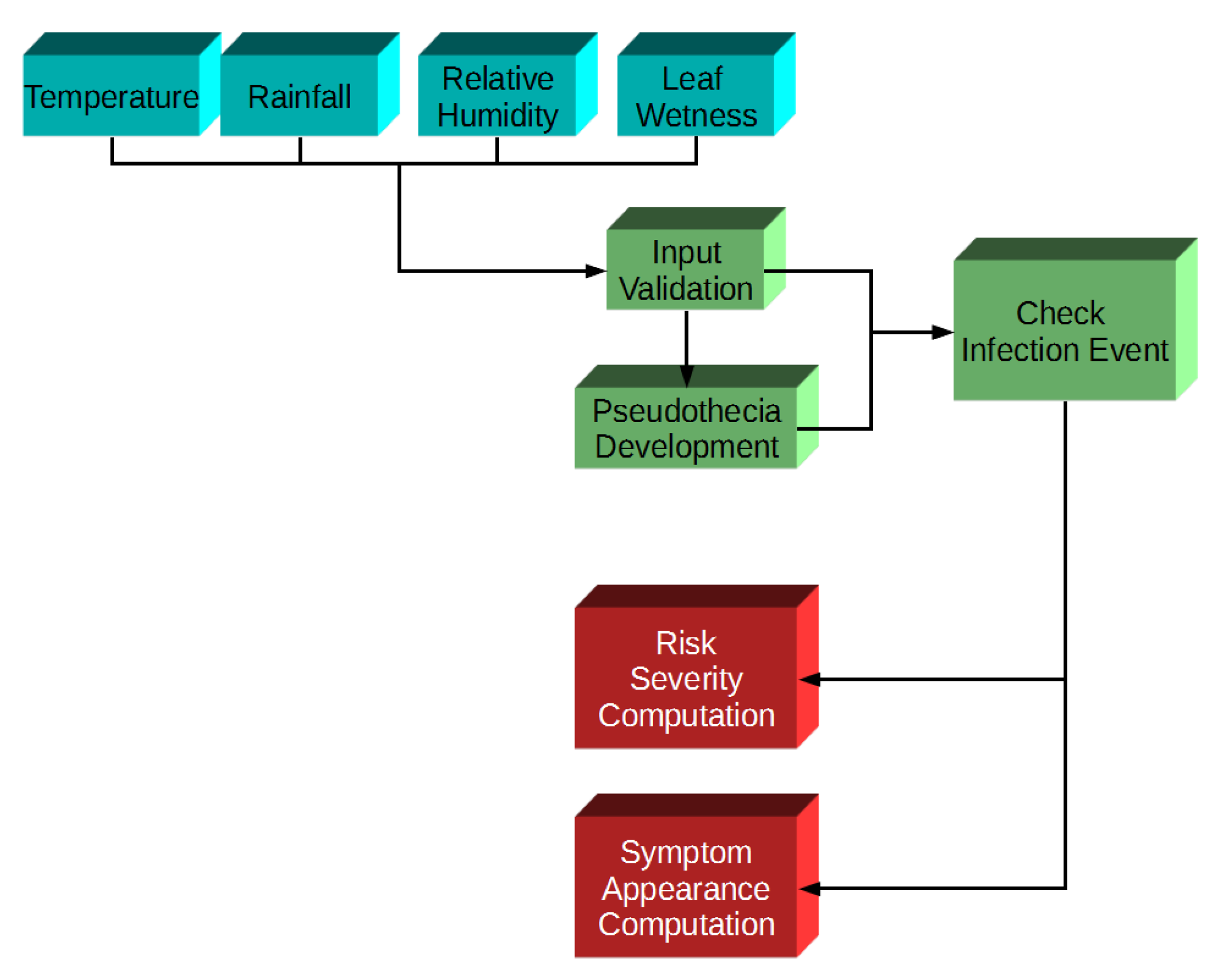

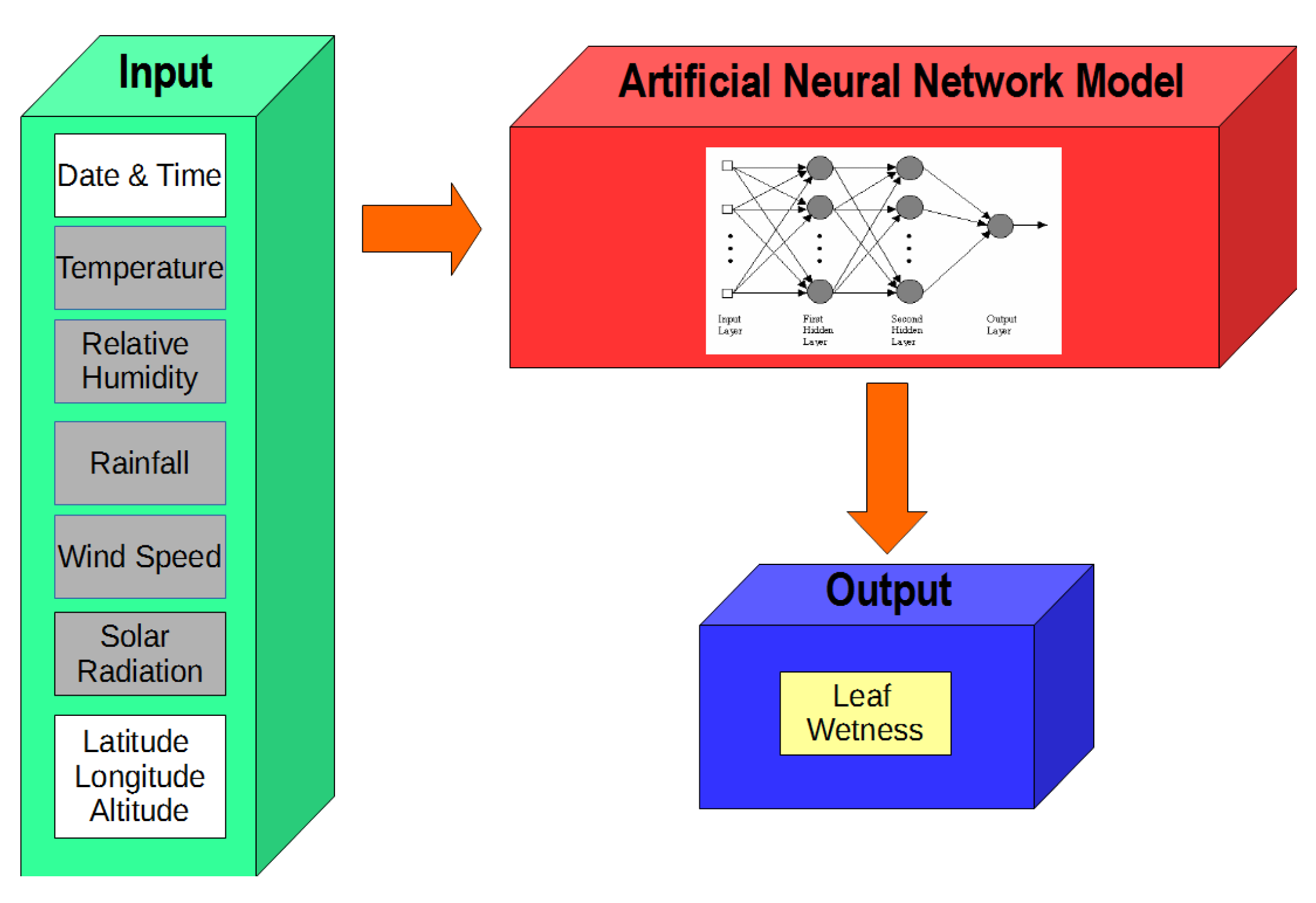
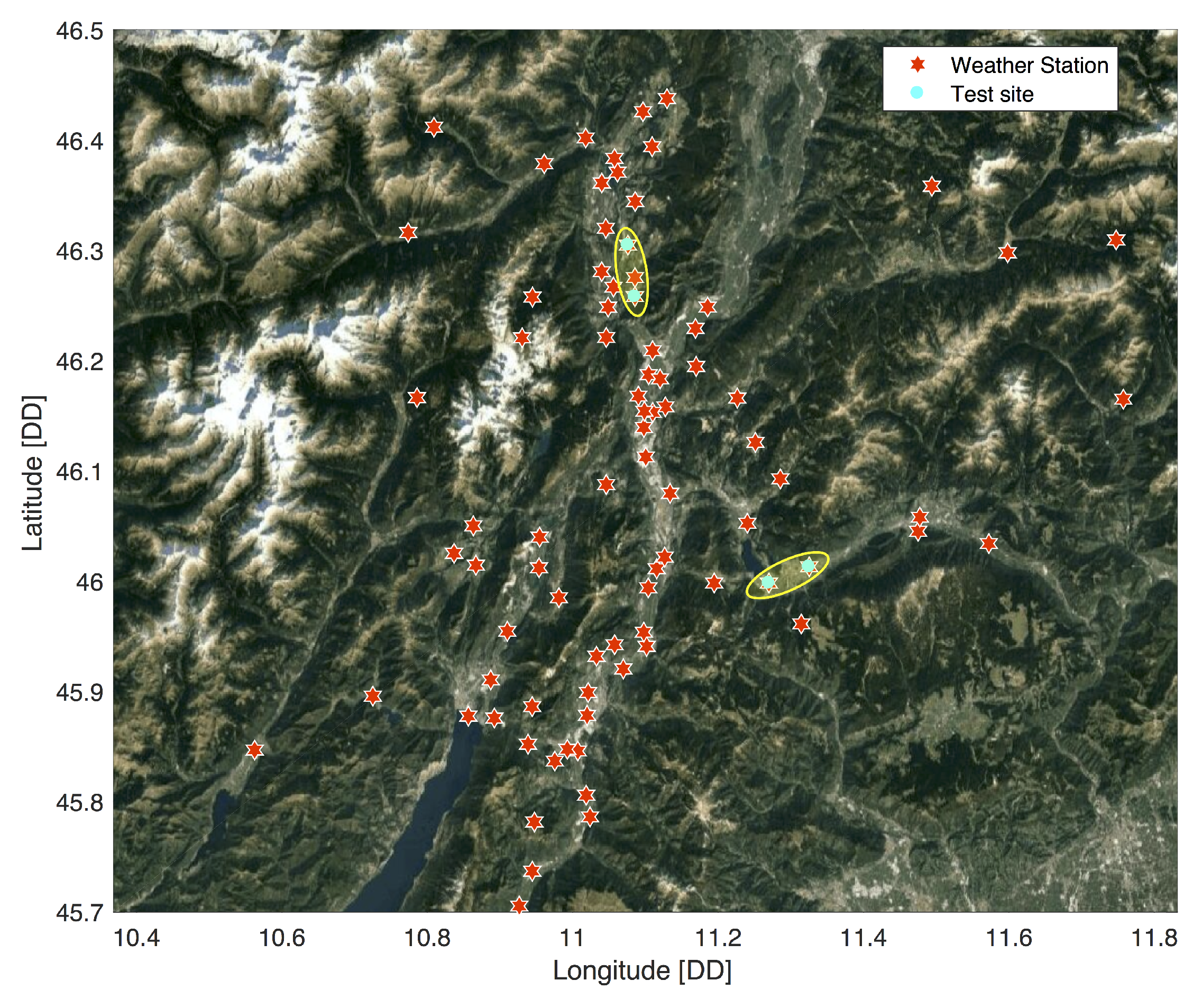




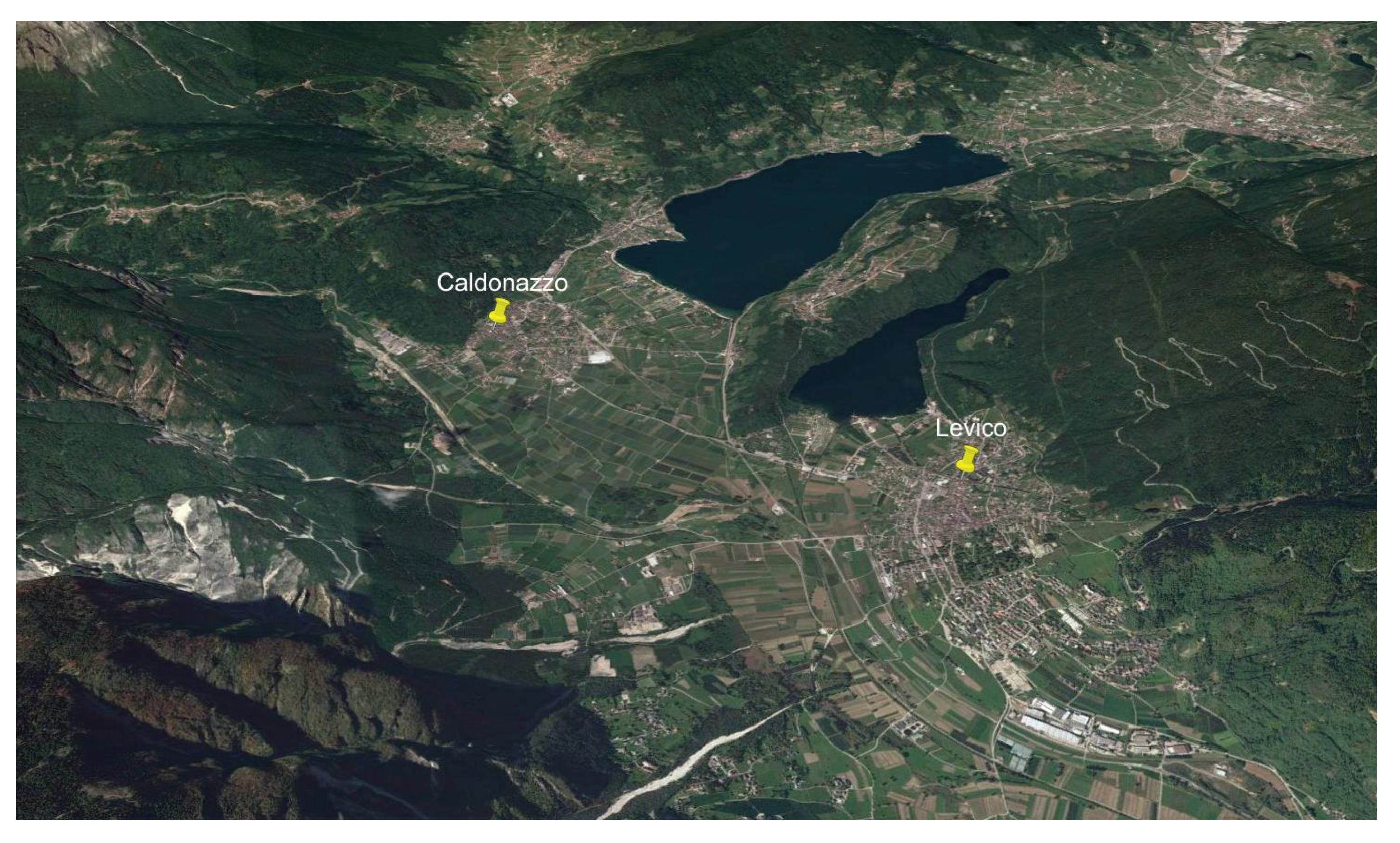




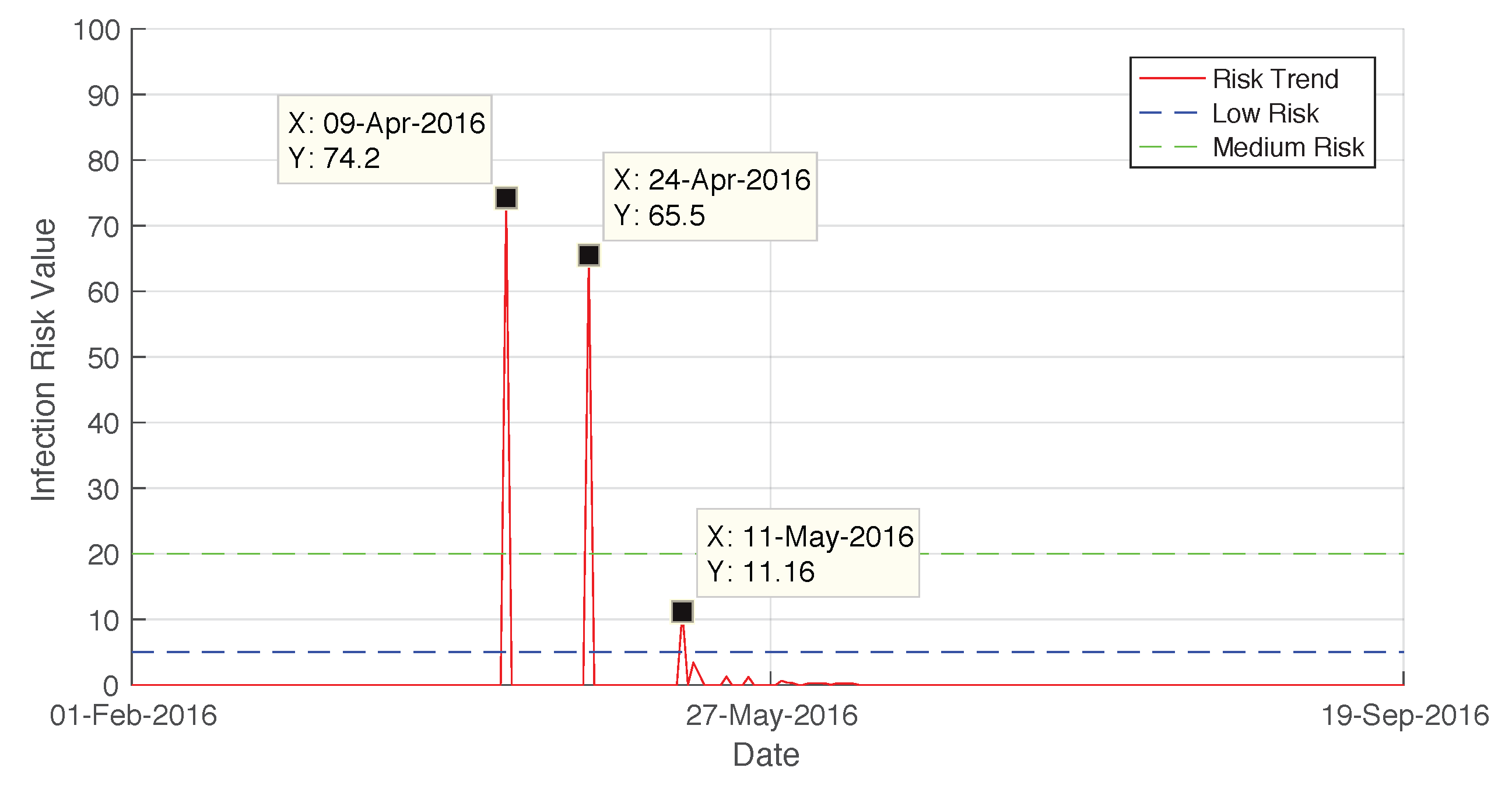
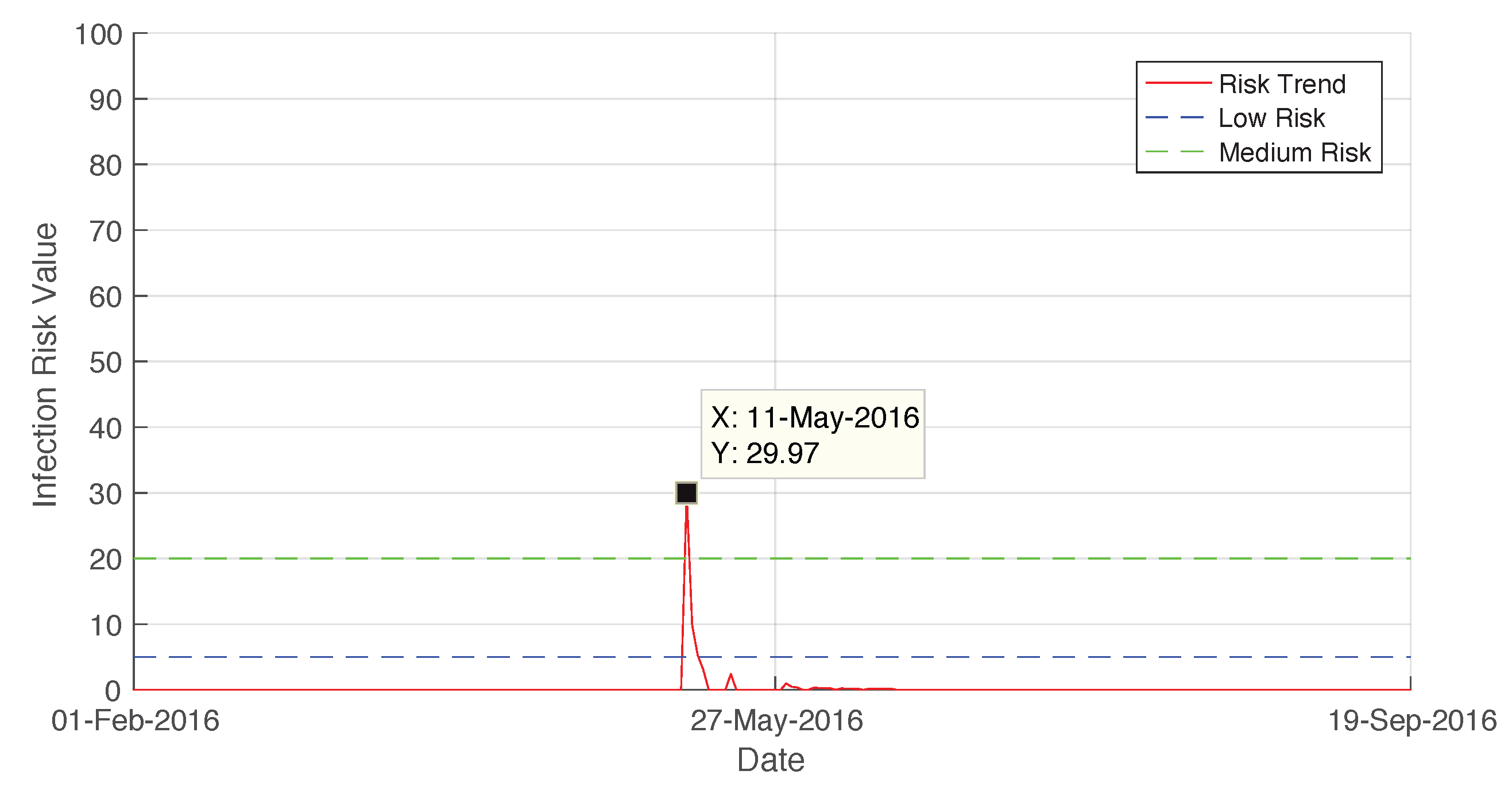
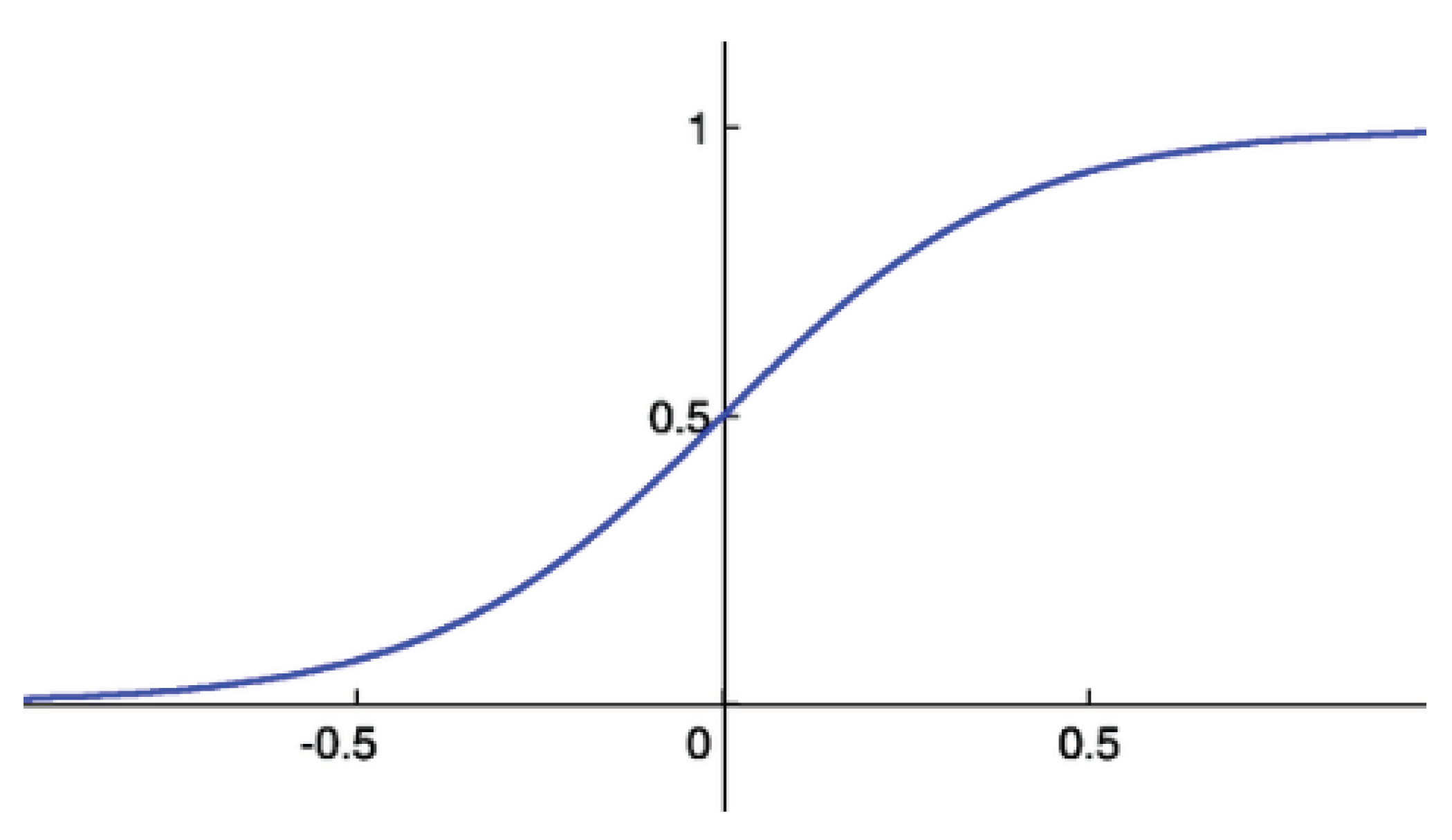
| Weather Station | Latitude [DD] | Longitude [DD] | Altitude (m) |
|---|---|---|---|
| Caldonazzo | 45.99825 | 11.2699 | 461 |
| Levico | 46.01302 | 11.3253 | 449 |
| Weather Station | Latitude [DD] | Longitude [DD] | Altitude (m) |
|---|---|---|---|
| Segno | 46.3048 | 11.076 | 525 |
| Ton | 46.258 | 11.0856 | 443 |
| Weather Station | REE Value (%) | Weather Station | REE Value (%) |
|---|---|---|---|
| Ala | 56 | Aldeno | −2 |
| Arco | 83 | Arsio | 83 |
| Avio | −2 | Banco Casez | −2 |
| Baselga di Piné | −2 | Besagno | 55 |
| Besenello | 67 | Bezzecca | −2 |
| Bleggio Superiore | −2 | Borgo Valsugana | 61 |
| Brancolino | −2 | Caldes | 66 |
| Caldonazzo | 87 | Cavedine | 52 |
| Cembra | −2 | Cles | −2 |
| Cognola | −2 | Coredo | −2 |
| Cunevo | −2 | Denno | 66 |
| Dercolo | −2 | Dro | 47 |
| Faedo | −2 | Fondo | −2 |
| Gardolo | 53 | Giovo | 69 |
| Lavazé | −2 | Lavis | 23 |
| Levico | −2 | Livo | 68 |
| Lomaso | −2 | Loppio | 83 |
| Malga Flavona | −2 | Mama di Avio | 66 |
| Marco | −2 | Maso Callianer | −2 |
| Mezzocorona Novali | 33 | Mezzocorona Piovi Veci | −1 |
| Mezzolombardo | 43 | Mori | 47 |
| Nago | −2 | Nanno | −2 |
| Nave San Rocco | −2 | Nomi | 87 |
| Ospedaletto | 74 | Paneveggio | −2 |
| Passo Vezzena | −2 | Pedersano | −2 |
| Pellizzano | −2 | Pergine | 59 |
| Pietramurata | 86 | Pinzolo Prà Rodont | −2 |
| Polsa | −2 | Predazzo | −2 |
| Pressano | 80 | Rabbi | −2 |
| Revo | 66 | Riva del Garda | −2 |
| Romagnano | −2 | Romeno | −2 |
| Ronzo Chienis | −2 | Rovere della Luna | 50 |
| Rovereto | −2 | San Michele all Adige | −2 |
| Sant Orsola | 60 | Sarche | |
| Savignano | −2 | Segno | 85 |
| Serravalle | 58 | Spormaggiore | 78 |
| Stenico | −2 | Storo | 83 |
| Telve | 72 | Terlago | 24 |
| Terzolas | −1 | Ton | 80 |
| Toss Castello | −2 | Trento Sud | −2 |
| Verla | 38 | Vigolo Vattaro | 76 |
| Volano | −2 | Zambana | 67 |
| Zortea | −2 |
| Weather Station | Latitude [DD] | Longitude [DD] | Altitude (m) |
|---|---|---|---|
| San Michele | 46.1835 | 11.12022 | 204 |
| San Michele External | 46.1964 | 11.17147 | 726 |
© 2017 by the authors. Licensee MDPI, Basel, Switzerland. This article is an open access article distributed under the terms and conditions of the Creative Commons Attribution (CC BY) license (http://creativecommons.org/licenses/by/4.0/).
Share and Cite
Stella, A.; Caliendo, G.; Melgani, F.; Goller, R.; Barazzuol, M.; La Porta, N. Leaf Wetness Evaluation Using Artificial Neural Network for Improving Apple Scab Fight. Environments 2017, 4, 42. https://doi.org/10.3390/environments4020042
Stella A, Caliendo G, Melgani F, Goller R, Barazzuol M, La Porta N. Leaf Wetness Evaluation Using Artificial Neural Network for Improving Apple Scab Fight. Environments. 2017; 4(2):42. https://doi.org/10.3390/environments4020042
Chicago/Turabian StyleStella, Alessandro, Gennaro Caliendo, Farid Melgani, Rino Goller, Maurizio Barazzuol, and Nicola La Porta. 2017. "Leaf Wetness Evaluation Using Artificial Neural Network for Improving Apple Scab Fight" Environments 4, no. 2: 42. https://doi.org/10.3390/environments4020042







